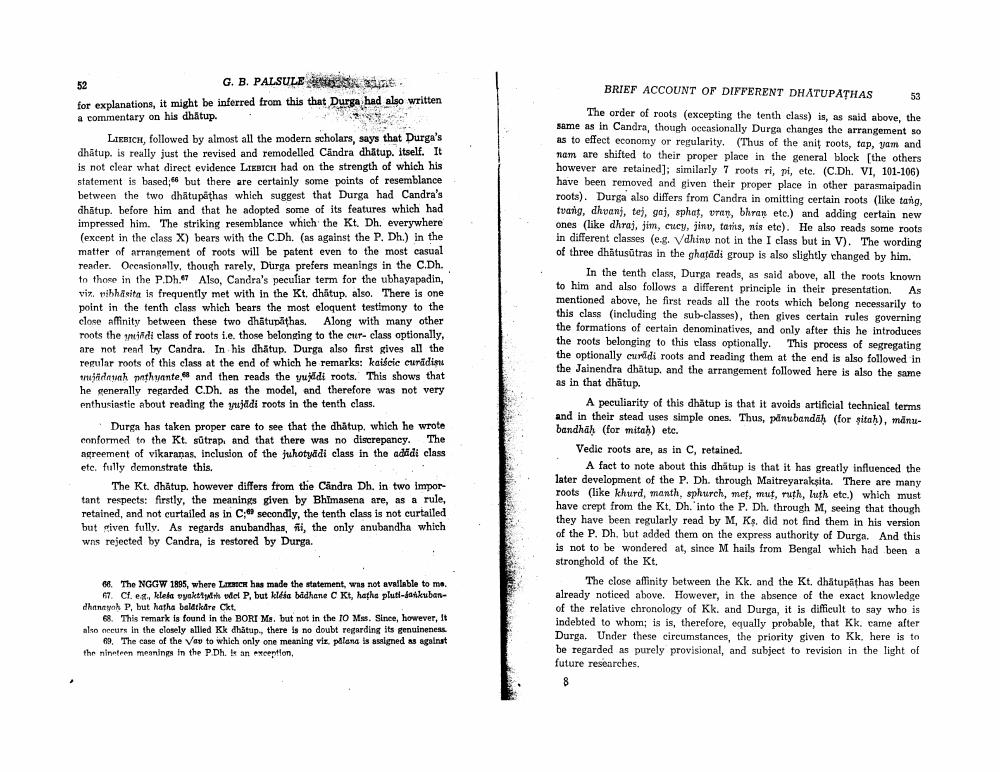Book Title: Brief Account Of Different Dhatupatras Author(s): G B Palsule Publisher: G B Palsule View full book textPage 9
________________ 52 BRIEF ACCOUNT OF DIFFERENT DHATUPATHAS . G. B. PALSULE MOSK, . for explanations, it might be inferred from this that Durga had also written a commentary on his dhatup. LIEBICH, followed by almost all the modern scholars, says that Durga's dhatup. is really just the revised and remodelled Candra dhatup. itself. It is not clear what direct evidence LIEBICH had on the strength of which his statement is based;66 but there are certainly some points of resemblance between the two dhatupathas which suggest that Durga had Candra's dhatup. before him and that he adopted some of its features which had impressed him. The striking resemblance which the Kt. Dh. everywhere (except in the class X) bears with the C.Dh. (as against the P. Dh.) in the matter of arrangement of roots will be patent even to the most casual reader. Occasionally, though rarely, Durga prefers meanings in the C.Dh. to those in the P.Dh.67 Also, Candra's peculiar term for the ubhayapadin, viz. vibhasita is frequently met with in the Kt. dhatup. also. There is one point in the tenth class which bears the most eloquent testimony to the close affinity between these two dhatupathas. Along with many other roots the yujadi class of roots i.e, those belonging to the cur- class optionally, are not read by Candra. In his dhatup. Durga also first gives all the regular roots of this class at the end of which he remarks: kaiscic curadisu wujadayah pathyante.68 and then reads the yujadi roots. This shows that he generally regarded C.Dh. as the model, and therefore was not very enthusiastic about reading the yujadi roots in the tenth class. The order of roots (excepting the tenth class) is, as said above, the same as in Candra, though occasionally Durga changes the arrangement so as to effect economy or regularity. (Thus of the anit roots, tap, yam and nam are shifted to their proper place in the general block [the others however are retained]; similarly 7 roots ri, pi, etc. (C.D. VI, 101-106) have been removed and given their proper place in other parasmaipadin roots). Durga also differs from Candra in omitting certain roots (like tang, tvang, dhvanj, tej, gaj, sphat, vraa, bhran etc.) and adding certain new ones (like dhraj, jim, cucy, jiny, taris, nis etc). He also reads some roots in different classes (e.g. Vdhinv not in the I class but in V). The wording of three dhatusutras in the ghatadi group is also slightly changed by him. In the tenth class, Durga reads, as said above, all the roots known to him and also follows a different principle in their presentation. As mentioned above, he first reads all the roots which belong necessarily to this class (including the sub-classes), then gives certain rules governing the formations of certain denominatives, and only after this he introduces the roots belonging to this class optionally. This process of segregating the optionally curadi roots and reading them at the end is also followed in the Jainendra dhatup, and the arrangement followed here is also the same as in that dhatup. Durga has taken proper care to see that the dhatup. which he wrote conformed to the Kt. sutrap, and that there was no discrepancy. The agreement of vikaranas, inclusion of the juhotyadi class in the adadi class etc. fully demonstrate this. The Kt. dhatup. however differs from the Candra Dh, in two important respects: firstly, the meanings given by Bhimasena are, as a rule, retained, and not curtailed as in C:69 secondly, the tenth class is not curtailed but given fully. As regards anubandhas, ni, the only anubandha which was rejected by Candra, is restored by Durga. 29 A peculiarity of this dhatup is that it avoids artificial technical terms and in their stead uses simple ones. Thus, panubandah (for sitah), manubandhah (for mitah) etc. Vedic roots are, as in C, retained. A fact to note about this dhatup is that it has greatly influenced the later development of the P. Dh. through Maitreyaraksita. There are many roots (like khurd, manth, sphurch, met, mut, ruth, luth etc.) which must have crept from the Kt. Dh. into the P. Dh, through M, seeing that though they have been regularly read by M, Ks. did not find them in his version of the P. Dh. but added them on the express authority of Durga. And this is not to be wondered at, since M hails from Bengal which had been a stronghold of the Kt. The close affinity between the Kk. and the Kt. dhatupathas has been already noticed above. However, in the absence of the exact knowledge of the relative chronology of Kk. and Durga, it is difficult to say who is indebted to whom; is is, therefore, equally probable, that Kk, came after Durga. Under these circumstances, the priority given to Kk. here is to be regarded as purely provisional, and subject to revision in the light of future researches. 68. The NGGW 1895, where LTEBICH has made the statement, was not available to mo. 67. Cf. e.g., klesa vyaktiyar vaci P, but klesa badhane C Kt, hatha pluti-sankubandhanayoh P, but hatha balatkare Ckt. 68. This remark is found in the BORI Ms. but not in the 10 Mss. Since, however, it also occurs in the closely allied Kk dhatup., there is no doubt regarding its genuineness. 69. The case of the Vav to which only one meaning viz. palana is assigned as against the nineteen meanings in the P.Dh. is an exception.Page Navigation
1 ... 7 8 9
